Hi,
This is my first post on Overclockers.com and I wanted to use it to share with you a project I have recently completed. Last year I upgraded my system to a 770GTX graphics card, Asus X99 motherboard with 16GB of crucial ballistix memory and an I7 5820K CPU. Previously I'd been running an AMD B55 with 4 unlocked cores and a Radeon 5770 which was cooled via my old and robust koolance Exos. After upgrading and plumbing in the new GPU and CPU into the Koolance it struggled with keeping the GPU temperatures below 65-70 degrees C and the CPU below 55 degress C. The coolant would often reach 55 degrees during gaming which revved up the fans and made for a pretty big distraction, it also ended up with me soon having the warmest room in the house! I decided enough was enough and I need a new cooling solution. I decided to keep the internal plumbing the same and just relocate the external disconnects from the Koolance back plate to some pre cut holes. I also decided that I wanted absolute silence and no extra heat in the room. So the dicission was made to mount the radiator outside. Below is a list of the cooling components I used for the project:
Radiator:
Alphacool NexXos UT60 240mm
http://www.alphacool.com/product_info.php/info/p983_Alphacool-NexXxoS-UT60-Full-Copper-240mm.html
Fans:
Phobya Nano 2G
http://www.watercoolinguk.co.uk/p/P...0rpm-Red-LED-Double-Blade-120x25mm_20616.html
Coolant:
Mayhems Red X1
http://www.overclockers.co.uk/showproduct.php?prodid=WC-002-MH&groupid=962&catid=1531&subcat=2414
Pump/Reservoir:
EK-XRES 140 D5 PWM
http://www.ekwb.com/shop/reservoirs-and-acc/res-pump-combo/ek-d5/ek-xres-140-d5-pwm-incl-pump.html
Connectors:
Monsoon 90 degree rotary fittings + centre line compression fittings
http://www.watercoolinguk.co.uk/p/Monsoon-1610mm-OD-58-Light-Port-Rotary-90Acirc;-White_34687.html
Bulkhead connector:
Alphacool bulkhead conectors
http://www.alphacool.com/product_in...language=en&XTCsid=5q3s2ielipvd4e1ec49r3r5pi3
Also a 4 way Mod-my-Toys PWM fan splitter
This was pretty much it from a watercooling parts perspective. Next I got the wifes permission to drill 2 20mm holes in the wall and began.
I bought an IP55 rated electric junction box, drilled some mounting holes in the front and cut out an appature before mounting the radiator. The fans were IP56 rated and probably the best I could find for use outdoor. I don't expect them to get wet as they are inside the case and there will be a vent mounted to the front eventually. I also mounted the fan splitter in the box and drilled a total of 9 25mm holes along the bottom and sides of the box and covered them with mesh to act as exhaust for the warm air.


I decided the pump/res would be mounted in side so I was passing a little as possible through the wall. In the end I had just 2 16mm tubes and a single 4 ping fan cable going through the wall. I also wanted the inside fittings and attachements to look nice rather than 2 holes and a bunch of fittings badly screwed to the wall. So I bought an off cut of carbon fibre and a 20mm diamond hole cutter (£5.95 from Amazon!) and went about mounting the interior parts.


I setup the pump out put to go straight to the PC, this way any liquid left in the radiator over night and potentially very cold would first be pumped into the reservoir which had room temperature water, and therefore minimise and possibility of start up condensation on inter parts.
Here is the finished item all filled, bled and working:

The wires are for pump power, fan power and a speed signal to the pump. I plan on tidying these up into a single heat shield wrapped cable. The pump speed signal and fan both connect to the X99 motherboard fan connectors which are able to control their speed in relation to the CPU temp. So far over all temperatures of the GPU and CPU have dropped by up to 20 degrees and peak at around 45 for the CPU and 50 whilst gaming. The radiator box outside never catches the sun and will always have a source of air cooler than the air in the room which my Koolance Exos was using and in turn heating.
In terms of condensation there hasn't been any, and the last week or so have been cold! The cold is not transferred along the pipes to the inside when it is turned off and the heat load from the computer keeps the coolant above room temperature during operation. I also specifically went for a coolant that wouldn't freeze until reaching -17 degrees C.
All in all I'm very pleased. I'd googled outdoor radiators previously as I researched my project but whilst there were plenty of people with opinions fore and against there were none who had actually done it. The system is absolutely silent during normal work load with a slight hum from the pump during gaming, but that is covered by the games sound! I'll get some pictures of the radiator finally mounted outdoor. Given the width of my path down the side of the house and the hight of the box from the ground it was quite an undertaking as the ladder ended up at 80 degrees! I'm also planning to upgrade my case, hence the lack of work to find clean routing for the power and signal wires
This is my first post on Overclockers.com and I wanted to use it to share with you a project I have recently completed. Last year I upgraded my system to a 770GTX graphics card, Asus X99 motherboard with 16GB of crucial ballistix memory and an I7 5820K CPU. Previously I'd been running an AMD B55 with 4 unlocked cores and a Radeon 5770 which was cooled via my old and robust koolance Exos. After upgrading and plumbing in the new GPU and CPU into the Koolance it struggled with keeping the GPU temperatures below 65-70 degrees C and the CPU below 55 degress C. The coolant would often reach 55 degrees during gaming which revved up the fans and made for a pretty big distraction, it also ended up with me soon having the warmest room in the house! I decided enough was enough and I need a new cooling solution. I decided to keep the internal plumbing the same and just relocate the external disconnects from the Koolance back plate to some pre cut holes. I also decided that I wanted absolute silence and no extra heat in the room. So the dicission was made to mount the radiator outside. Below is a list of the cooling components I used for the project:
Radiator:
Alphacool NexXos UT60 240mm
http://www.alphacool.com/product_info.php/info/p983_Alphacool-NexXxoS-UT60-Full-Copper-240mm.html
Fans:
Phobya Nano 2G
http://www.watercoolinguk.co.uk/p/P...0rpm-Red-LED-Double-Blade-120x25mm_20616.html
Coolant:
Mayhems Red X1
http://www.overclockers.co.uk/showproduct.php?prodid=WC-002-MH&groupid=962&catid=1531&subcat=2414
Pump/Reservoir:
EK-XRES 140 D5 PWM
http://www.ekwb.com/shop/reservoirs-and-acc/res-pump-combo/ek-d5/ek-xres-140-d5-pwm-incl-pump.html
Connectors:
Monsoon 90 degree rotary fittings + centre line compression fittings
http://www.watercoolinguk.co.uk/p/Monsoon-1610mm-OD-58-Light-Port-Rotary-90Acirc;-White_34687.html
Bulkhead connector:
Alphacool bulkhead conectors
http://www.alphacool.com/product_in...language=en&XTCsid=5q3s2ielipvd4e1ec49r3r5pi3
Also a 4 way Mod-my-Toys PWM fan splitter
This was pretty much it from a watercooling parts perspective. Next I got the wifes permission to drill 2 20mm holes in the wall and began.
I bought an IP55 rated electric junction box, drilled some mounting holes in the front and cut out an appature before mounting the radiator. The fans were IP56 rated and probably the best I could find for use outdoor. I don't expect them to get wet as they are inside the case and there will be a vent mounted to the front eventually. I also mounted the fan splitter in the box and drilled a total of 9 25mm holes along the bottom and sides of the box and covered them with mesh to act as exhaust for the warm air.
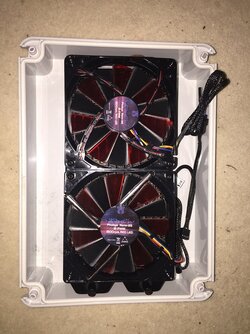
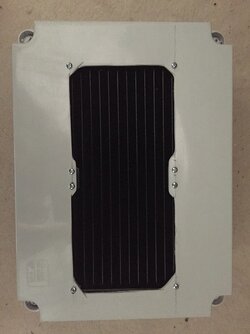
I decided the pump/res would be mounted in side so I was passing a little as possible through the wall. In the end I had just 2 16mm tubes and a single 4 ping fan cable going through the wall. I also wanted the inside fittings and attachements to look nice rather than 2 holes and a bunch of fittings badly screwed to the wall. So I bought an off cut of carbon fibre and a 20mm diamond hole cutter (£5.95 from Amazon!) and went about mounting the interior parts.
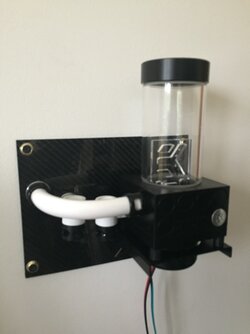
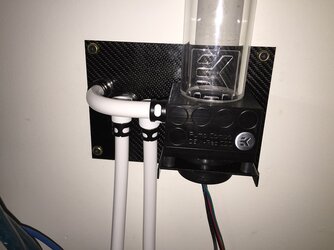
I setup the pump out put to go straight to the PC, this way any liquid left in the radiator over night and potentially very cold would first be pumped into the reservoir which had room temperature water, and therefore minimise and possibility of start up condensation on inter parts.
Here is the finished item all filled, bled and working:
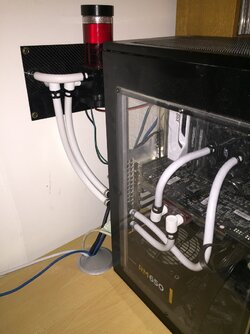
The wires are for pump power, fan power and a speed signal to the pump. I plan on tidying these up into a single heat shield wrapped cable. The pump speed signal and fan both connect to the X99 motherboard fan connectors which are able to control their speed in relation to the CPU temp. So far over all temperatures of the GPU and CPU have dropped by up to 20 degrees and peak at around 45 for the CPU and 50 whilst gaming. The radiator box outside never catches the sun and will always have a source of air cooler than the air in the room which my Koolance Exos was using and in turn heating.
In terms of condensation there hasn't been any, and the last week or so have been cold! The cold is not transferred along the pipes to the inside when it is turned off and the heat load from the computer keeps the coolant above room temperature during operation. I also specifically went for a coolant that wouldn't freeze until reaching -17 degrees C.
All in all I'm very pleased. I'd googled outdoor radiators previously as I researched my project but whilst there were plenty of people with opinions fore and against there were none who had actually done it. The system is absolutely silent during normal work load with a slight hum from the pump during gaming, but that is covered by the games sound! I'll get some pictures of the radiator finally mounted outdoor. Given the width of my path down the side of the house and the hight of the box from the ground it was quite an undertaking as the ladder ended up at 80 degrees! I'm also planning to upgrade my case, hence the lack of work to find clean routing for the power and signal wires
Last edited:
 to OCFs!
to OCFs! 